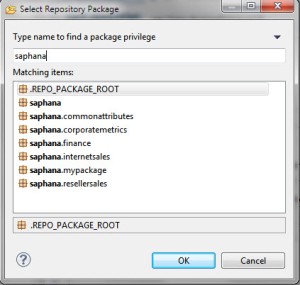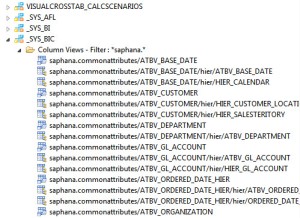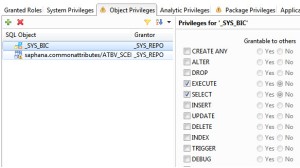
As more and more organization implement SAP HANA native, S4/HANA or sidecar solutions, the need to understand how to provide access and secure information views has emerge. The intent of this article is to provide the reader with a few technical details relevant to securing SAP HANA information views.
Before we describe how to secure an information view, let’s quickly define the various information views that are available within SAP HANA.
Attribute Views
Attribute Views are created to serve as a reusable type of view. Developers will create Attribute Views to represent items such as customers, products, dates, salespersons and cost centers. Once activated, they can be joined to one or more analytic view data foundations. Within an attribute view we can also create Hierarchies.
Analytic Views
Analytic Views are created to serve as the SAP HANA Cube. When designing the analytic view, developers will design a data foundation using transaction columnar tables found in a SAP HANA schema after provisioning data. The analytic view data foundation is then joined to existing attribute views in the logical join foundation. In the final stage of development, two items are identified. First attribute views and private attribute are identified as Attributes. Numeric Fields are identified, aggregated and marked as measures.
Calculation views
Calculation views were originally created to address complex calculations or to virtually model data sets into the desired format. They can use attribute views, analytic views or columnar tables as their source. They support modeling transforms such as join, union, aggregate and project. They are created using using either a GUI or a script using SAP HANA SQLScript. The final output of a calculation view can contain attributes, measures and hierarchies.
Note: Starting with SAP HANA 2.0 we should start using Dimensional Calculation Views and Star Join Calculation Views as replacements for Attribute Views and Analytic View.
Analytic Privileges
Analytic Privileges are not technically an information view. However they are closely associated with information views. In general, they provide both information view query access and row level security. When you create a SAP HANA user or role, you can assign analytic privileges. Analytic privileges in turn provide security for information views.
General Information
All information views are created is SAP HANA Studio and their developer code is stored within the content and package hierarchy. When an information view is activated a series of SAP HANA specific column views are created in the _SYS_BIC schema. This is an important concept when securing SAP HANA information views. In general there are three areas where we need to define information view security. You must establish security for developer Packages, SQL Privileges on _SYS_BIC column views and Analytic Privileges.
Security Areas
Securing Packages
Packages need to be secured in order to define the level of access a SAP HANA developer has when creating or editing an information view. Users and BI tools do not access packages when they query an information view. Therefore this level of security does not affect access to the underlying data. It only establishes rights for developers using SAP HANA Studio.
- An example List of SAP HANA Packages
When adding package privileges to a SAP HANA user or role, the administrator can choose to provide access to the root package (all packages), a specific top level package or a specific sub package. All information views within the designated package will inherit the rights established for the selected package. If you grant the rights on the root package, all information views will assume the defined rights.
- SAP HANA Package Privileges
There are multiple privileges that can be assigned to a package for a given user or role. REPO.READ allows the developer to see the package and an information view definition but it will not allow the developer to make changes. The three rights for native packages apply to information views created directly in an environment. For example, information views created in the development environment. This is where we establish create and edit rights as well. The three rights for imported packages apply to information views that were imported from a development environment. This is handy if you want to prevent developers from making changes to imported packages within Production.
Securing column views in the _SYS_BIC schema
When a developer activates an information view within a SAP HANA package, the system generates one or more column views in the _SYS_BIC schema. When users or BI tools query an information view, they query the information view in the form of a column view. Column views are similar to standard database views but they are actually specialized views designed for the various SAP HANA query engines and Analytic Privileges.
- Above is a sample listing of column views that are created when an attribute view is activated.
Because column views are SQL objects, they must be secured for users and roles using object privileges (formally SQL privileges). Administrators can choose to either provide access to the entire _SYS_BIC schema or to the individual information views.
It is important to understand that there is an additional layer of information view security in the form of analytic privileges. Administrator can simply grant access to the entire _SYS_BIC schema and then leverage Analytic Privileges to secure the information view. However, as of SPS6 of SAP HANA developers can now choose to activate an information view that ignores analytic privileges. Therefore it is important to pay close attention to both _SYS_BIC Object privileges and Analytic Privileges.
At a minimum, users need the SELECT right on each information view’s associated column view. This can be assigned to the entire _SYS_BIC schema or to individual column views.
Analytic Privileges
Analytic Privileges are the final area where we can secure information views. They are not created in the normal security areas of SAP HANA. Instead they are created by developers (or Administrators) and stored within packages. With that said, they are assigned to users or roles by an Administrator in the normal security areas of SAP HANA studio. Some believe that Analytic Privileges are only used to provide row level security. This is not entirely true. Every user or role in SAP HANA must have an assigned analytic privilege to access an information view. However, there is a special analytic privilege named “_SYS_BI_CP_ALL” that can be assigned to grant full access. This Analytic Privileges effectively provides access to all information views and data rows. Be careful when assigning this analytic privilege. When you assign multiple privileges to a user, each individual privilege is honored. However, each subsequent privilege is assigned using an “OR” operator. This means that the least restrictive privilege will provide the access. Its too bad this “OR” condition can not be changed but this is how it works at the moment.
Analytic privileges provide two levels of access. First they grant access to an information view. They then have an extra optional layer of security that can restrict access to specific rows of data. This can be tricky to understand so you might want to read this a few times and then experiment in your own environment. On the right side of the Analytic Privilege design window developers can define one or more filters based on one or more attribute views. This is the area where we can setup row level security. Don’t forget that each assigned analytic privilege is assigned with an “OR” operator. If you truly want row level security, it can be a chore to setup a robust data level security model. You would have to create numerous database roles and multiple extreamly explicit analytic privilege filters. However, there is a way to setup a stored procedure driven model that can simplify this setup. For more information on this, visit the article found here
Note 1/1/2017: SAP HANA now supports both dynamic and SQL based analytic privileges. Both options greatly reduce the complexity, maintenance and setup requirements related to data level security.
The three areas described above all play a role in either securing content for developers or securing content for end users. For those looking to establish a security model for SAP HANA information views, I hope this information will give you a head start.







Reblogged this on SAP BI BLOG.
Hi Jonathan.
Very good detailed information, thanks.
I have a comment on “However, as of SPS6 of SAP HANA developers can now choose to activate an information view that ignores analytic privileges”.
I have not found this option, can you help ?
Sam
Hi Jonathan,
Thanks for the detailed level of information..It is really helpful in understanding the different views in a very simple and understandable language.
Annu Gupta
Hi,
We are having same issue what you have described in _SYS_BIC generated objects for Attribute Views. We like to avoid providing access to SELECT at _SYS_BIC schema level but at the same time do not want to list 100s of generated column view by attributes view as well.
How can we achieve above ?. Is their anyway view designed such a way so it does not check auth. for column view and we can provide access at Attribute view only ?
You mentioned, we can secure _SYS_BIC using Analytic Auth.? can you please tell us how ? Under reference Model selection in Analytical Auth. window there is no schema name selection.
We are having same issue what you have described in _SYS_BIC generated objects for Attribute Views. We like to avoid providing access to SELECT at _SYS_BIC schema level but at the same time do not want to list 100s of generated column view by attributes view as well.
How can we achieve above ?. Is their anyway view designed such a way so it does not check auth. for column view and we can provide access at Attribute view only ?
You mentioned, we can secure _SYS_BIC using Analytic Auth.? can you please tell us how ? Under reference Model selection in Analytical Auth. window there is no schema name selection.
A grantee must have SELECT on the _SYS_BIC schema or on individual column views within that schema in order to query an information view using SQL / MDX. The run-time version of an information view is published as a column view in the _SYS_BIC schema. You can either grant SELECT for the entire schema, thus reducing maintenance on the security model, or grant SELECT on each individual column view that an activated information view produces. Typically I grant SELECT on the entire schema because it is easier to maintain. Information views produce multiple column views when activated. It is difficult to keep track of each column view that a user will need when executing a query.
It then falls on the Analytic Privileges to govern access to a particular information view. A user must have an analytic privilege, in addition to the SELECT on _SYS_BIC, to query an information view. The only exceptions are information view that do not check for analytic privileges. You can configure information views to bypass the analytic privileges check thus falling back to the object privilege. In the end, the analytic privilege should determine which information view and what data is assessable to the user. Don’t rely on object privileges.
Jonathan,
Thank you for detail answer.
Approach of providing SELECT on _SYS_BIC concerns me over data security since user can access 1000s of columns view by providing this access which is kind of defeats the purpose of having security. Certainly it avoids maintenance over security.
We provide full SELECT access to Information view since business needs is to grant full access within specific views since those views are designed such a way so we do not need to put analytic privileges.
Let’s say, even I add analytic privilege, user will still able to access other _SYS_BIC column view which I do not meant to give to them correct ?.
That is not correct. A grantee always needs a combination of Object Privileges and Analytic Privileges to query an information view. (unless the information view was configured to bypass the AP check) Analytic Privileges provide both query and (optionally) data level access. For example, a user can have SELECT on _SYS_BIC but no Analytic Privileges for a given information view. When they query that information view, they will get the error message “not authorized”. This is because they require an analytic privilege.
Jonathan,
Understood about user will not able to access Information view since Analytic Privileges will protect them but how about able to access to Column View directly as below ?. Will Analytic Privileges will protect that as well ? I have not tested so not sure.
Note: Reporting.Cost/CV_COST_ACCT_DETL/HIER_CMPNY/hier/HIER_CMPNY is system generated column view
e.g. SELECT * FROM “_SYS_BIC”.”Reporting.Cost/CV_COST_ACCT_DETL/HIER_CMPNY/hier/HIER_CMPNY”;
Yes. It requires privileges for both the column view and AP.
Hi Jonathan,
Thanks for great blog explaining the APs (Analytical Privilege) and I was able to setup the AP.
In my scenario, need to row level security at country level, so created APs based on the country code USA, Canada and Mexico. There are some users who would need to see data only for specific country, some users would need to see data for two or more countries.
For one user assigned the AP for USA and other user assigned APs for USA and Canada ( that’s the sequence how the APs are assigned to user).
With this setup, 2nd user is getting only data for USA and not for Canada.
Can SAP HANA APs merge restrictions set in multiple APs? Is there any better approach to apply data restrictions from multiple APs, to give broader data access to user, similar to data roles normally setup in SAP BI?
Thanks,
Abhay
Multiple AP should merge using an “or” condition. User should get both. Not sure why your issue is happening. Try SQL AP or XML Classic dynamic AP as an alternative.
Hey Jonathan,
Thanks for the great content! This blog confirmed alot of what I have been discovering about HANA security.
I have a view security scenario that I have not been able to tackle though.
I have a calculation view(View A) that is built using other calculation views(View B, View C, etc.) placed in projection nodes and joined together to create complex calculations. I want the End User to only have access to View A in a BI tool like SAP Lumira. My problem is that, so far, in order to grant access to the data from View A I have to add View B and View C to the Analytical Privilege as well. Thereby granting the end user to also see those views in Lumira.
Do you know a solution here to limit the End User to only see the data from View A?
Thanks,
Jonathan
There is a CV option where you can hide the view from reporting tools. Look for the data category option. Based on the hover text, you can hide the view by setting the category to blank. I know this works for Lumira and other tools that directly connect to HANA without a Universe.
If I define two SQL analytic privilege(say SQL_01, SQL_02), and two classic privileges (CLA_01, CLA02), and I assign all of them to user alongwith _SYS_BI_CP_ALL,
And I Have two views
V1 – has SQL analytic privilege
V2 – has classic analytic privilege
How are authorizations applied? Is this understanding correct:
V1 – _SYS_BI_CP_ALL AND (SQL_01 OR SQL_02)
V2 – _SYS_BI_CP_ALL OR (CLA_01 OR CLA_02)
I couldn’t find specific answer to this anywhere.
_SYS_BI_CP_ALL only applies to views with the classic XML based AP check enabled. SQL APs do not respect _SYS_BI_CP_ALL.
V1 – (_SYS_BI_CP_ALL is ignored) AND (only SQL_01 OR SQL_02 are applied)
V2 – _SYS_BI_CP_ALL OR (CLA_01 OR CLA_02)
Looking for a table that would show a relationship between the data model(s) and the attribute(s) in APs. View STRUCTURED_PRIVILEGES seems to have most of the information however it does not show which data model is linked to which attribute when you look at the view contents. It does however show it when you look at the AP in HANA studio